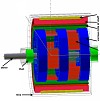 According to the UK’s Energy Savings Trust we have at least 12 gadgets on standby or recharging at any one time, including TVs, mobile phones, mp3 players, which adds up to a cost of about 40 pounds ($80) a year on domestic electricity bills. There is a strong call from environmental lobbyists for us to power down our electrical devices and now John Clare, outgoing head of one of the UK’s biggest high street electrical retailers, is calling on manufacturers to eradicate the “standby” button from devices such as DVD players and TVs.
According to the UK’s Energy Savings Trust we have at least 12 gadgets on standby or recharging at any one time, including TVs, mobile phones, mp3 players, which adds up to a cost of about 40 pounds ($80) a year on domestic electricity bills. There is a strong call from environmental lobbyists for us to power down our electrical devices and now John Clare, outgoing head of one of the UK’s biggest high street electrical retailers, is calling on manufacturers to eradicate the “standby” button from devices such as DVD players and TVs.
According to Clare, when given a choice between a less efficient and a more energy efficient product, customers choose the least costly option. “Standby buttons costs so much money and produce carbon emissions,” he told BBC Radio 4’s Today show, “of which many consumers are not aware.” He suggests that because our modern lifestyles demand so many electrical gadgets that the onus should be on the manufacturers to produce more energy-efficient products and for retailers to keep the consumer informed of the energy ratings of these devices and not just the “white goods”, such as washers and dryers which already have an efficiency code.
The interviewer pointed out to Clare that the standby mode on a television is very important to the elderly and those of limited mobility. Clare responded by saying that such people can “use remote controls”. At this point, I got rather confused. He is advocating that manufacturers get rid of the proverbial “standby button”, which means that a device would be fully powered down to save energy. That’s fine, sounds sensible. But, if there is no standby mode and the device is fully “off”, how will a remote control help the elderly person who may not be able to clamber from their chair, bend to switch the TV on? Doesn’t the remote control require the device to be in a ready, “standby” state before it will function.
Clare then back peddled slightly and said that the standby button could perhaps be a kind of optional accessory that those of us capable of bending to reboot our TVs could have so that we might save that $80 or so a year. But, generally the elderly are those who might benefit the most from such an annual saving, and they would essentially be excluded by having to choose the standby button option.
It is true that the dreaded standby button is wasting energy, there are claims of their using up to 8% of total device consumption. But, there is evidence that hard powering devices on and off reduces their lifespan considerably compared to standby mode.
Regardless, the “Western” lifestyle, overall is far more of a problem. The amount of energy wasted by standby mode is trivial compared to the amount of energy wasted in using a washer-dryer several times a week. Even the “A” class, most energy efficient white goods use vast amounts of water (which costs energy to produce) and electricity, and the juice pulled by a standard television when in use far outweighs even the most inefficient standby mode. The Energy Saving Trust asserts that we should power down fully and switch off our chargers (presumably that includes those that don’t have trickle mode and so use no electricity when charged to capacity!).
The real problem is not standby mode at all. It is our attitude to consumption in general. Admittedly, there is an old adage that we should look after the pennies, and the pounds (dollars) will look after themselves. But, when it comes to power and water consumption, this is simply not true. Save a few milliwatt hours by unplugging your charger every day is not going to offset the consumption inherent in running a mobile phone network (all the construction and maintenance and operation of powered masts and exchange systems) nor the same for TV.
It makes sense to power down properly, but do not think it will save the world. Getting rid of your electrical laundry goods, TV, and car, might. But eradicating the standby button most certainly won’t.
 Today, Philippe Masson of the FAMU-FSU College of Engineering and Center for Advanced Power Systems and colleagues at NASA and Georgia Tech publish details of an entirely new class of aircraft engine that, if it takes off, could lead to an all-electric aircraft that would cut airport pollution and reduce aircraft vapor trails to a distant memory. You can read my write-up about the work on the AlphaGalileo site here.
Today, Philippe Masson of the FAMU-FSU College of Engineering and Center for Advanced Power Systems and colleagues at NASA and Georgia Tech publish details of an entirely new class of aircraft engine that, if it takes off, could lead to an all-electric aircraft that would cut airport pollution and reduce aircraft vapor trails to a distant memory. You can read my write-up about the work on the AlphaGalileo site here. Laboratory spectrometers are great lumbering beasts, essentially tied to the bench and useless for slipping into an overnight bag and heading off for a spot of analytical field work. Thankfully researchers are working on changing all that, at least in the area of atomic spectroscopy.
Laboratory spectrometers are great lumbering beasts, essentially tied to the bench and useless for slipping into an overnight bag and heading off for a spot of analytical field work. Thankfully researchers are working on changing all that, at least in the area of atomic spectroscopy.
 Different social media, such as wikis, MySpace, Flickr, and various forums have different ways for people to give and receive gifts, according to Swedish scientists.
Different social media, such as wikis, MySpace, Flickr, and various forums have different ways for people to give and receive gifts, according to Swedish scientists. According to the UK’s Energy Savings Trust we have at least 12 gadgets on standby or recharging at any one time, including TVs, mobile phones, mp3 players, which adds up to a cost of about 40 pounds ($80) a year on domestic electricity bills. There is a strong call from environmental lobbyists for us to power down our electrical devices and now John Clare, outgoing head of one of the UK’s biggest high street electrical retailers, is calling on manufacturers to eradicate the “standby” button from devices such as DVD players and TVs.
According to the UK’s Energy Savings Trust we have at least 12 gadgets on standby or recharging at any one time, including TVs, mobile phones, mp3 players, which adds up to a cost of about 40 pounds ($80) a year on domestic electricity bills. There is a strong call from environmental lobbyists for us to power down our electrical devices and now John Clare, outgoing head of one of the UK’s biggest high street electrical retailers, is calling on manufacturers to eradicate the “standby” button from devices such as DVD players and TVs.